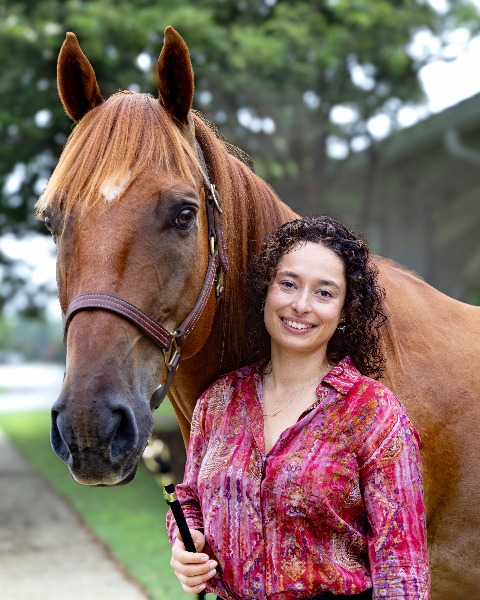Equine
In Person Only
E11 - Pulmonary Disposition and Pharmacokinetics of Ceftiofur Sodium After Nebulization in Adult Horses
Thursday, June 19, 2025
11:45 AM - 12:00 PM ET
Location: KICC L006
CE: 0.25 Medical

Lana Dedecker, MVetMed (she/her/hers)
Resident Large Animal Internal Medicine
Auburn University
Auburn, Alabama, United States
Research Abstract - Oral Presenter(s)
Abstract: Background
Ceftiofur sodium is commonly nebulized to treat lung infections in horses. Plasma and pulmonary pharmacokinetics have been described in foals but not in adult horses.
Hypothesis/Objectives
This study described pulmonary and plasma pharmacokinetics of desfuroylceftiofur sodium acetamide (DCA) following nebulized and intravenous (IV) administration of ceftiofur sodium in adult horses. It was hypothesized that 1) DCA would be detected in pulmonary epithelial lining fluid (PELF) and exceed minimal inhibitory concentrations (MIC) for gram-positive (0.12 µg/ml) and most gram-negative (2 µg/ml) bacteria; 2) nebulization would result in lower systemic (plasma) DCA exposure compared to IV administration.
Animals
Six healthy adult university research horses.
Methods
A single dose of ceftiofur sodium (2.2 mg/kg) was administered IV or nebulized using a Flexineb® standard medication cup in a randomized cross-over protocol. Serial plasma samples were collected, and bronchoalveolar lavage was performed and processed to obtain PELF at 1.5, 8 and 20 hours. Concentrations of DCA in both plasma and PELF were determined via high pressure liquid chromatography and used for noncompartmental pharmacokinetic analysis. Aerosolized particle size was quantified and rate of nebulization (ml/min) recorded.
Results
In PELF, DCA concentrations at 8 hours exceeded 0.12 µg/ml and 2 µg/ml in 6/6 and 5/6 horses after nebulization and 3/6 and 2/6 after IV, respectively (Figure 1). Plasma pharmacokinetics are summarized in table 1. Median particle diameter was 4.066 µm with 60% between 1-5 µm.
Conclusions
Nebulized administration of ceftiofur sodium results in PELF DCA concentrations above MIC for pathogens encountered in equine bacterial pneumonia.
Ceftiofur sodium is commonly nebulized to treat lung infections in horses. Plasma and pulmonary pharmacokinetics have been described in foals but not in adult horses.
Hypothesis/Objectives
This study described pulmonary and plasma pharmacokinetics of desfuroylceftiofur sodium acetamide (DCA) following nebulized and intravenous (IV) administration of ceftiofur sodium in adult horses. It was hypothesized that 1) DCA would be detected in pulmonary epithelial lining fluid (PELF) and exceed minimal inhibitory concentrations (MIC) for gram-positive (0.12 µg/ml) and most gram-negative (2 µg/ml) bacteria; 2) nebulization would result in lower systemic (plasma) DCA exposure compared to IV administration.
Animals
Six healthy adult university research horses.
Methods
A single dose of ceftiofur sodium (2.2 mg/kg) was administered IV or nebulized using a Flexineb® standard medication cup in a randomized cross-over protocol. Serial plasma samples were collected, and bronchoalveolar lavage was performed and processed to obtain PELF at 1.5, 8 and 20 hours. Concentrations of DCA in both plasma and PELF were determined via high pressure liquid chromatography and used for noncompartmental pharmacokinetic analysis. Aerosolized particle size was quantified and rate of nebulization (ml/min) recorded.
Results
In PELF, DCA concentrations at 8 hours exceeded 0.12 µg/ml and 2 µg/ml in 6/6 and 5/6 horses after nebulization and 3/6 and 2/6 after IV, respectively (Figure 1). Plasma pharmacokinetics are summarized in table 1. Median particle diameter was 4.066 µm with 60% between 1-5 µm.
Conclusions
Nebulized administration of ceftiofur sodium results in PELF DCA concentrations above MIC for pathogens encountered in equine bacterial pneumonia.



